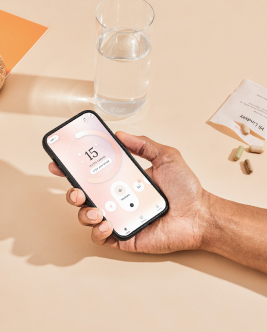science
Can You Really Get Vitamin D Through a Window? The Surprising Science Explained
On This Page

Vitamin D production is triggered in our bodies by skin exposed to the sun. Can you get enough sun exposure indoors and in the car through windows?
Vitamin D is an essential nutrient that is produced by the body when unprotected skin is exposed to the UVB rays of the sun. That’s why it’s often referred to as the “sunshine vitamin.” These UVB rays are most prevalent when the sun is at its highest point in the sky, typically midday between 10 a.m. and 2 p.m. The summer months are often the best time to soak in these rays because the sun is at its strongest. But there’s many other factors that go into getting an adequate amount of sunshine for your body to produce enough vitamin D.
Why is vitamin D important?
Vitamin D is used by systems throughout the body, making it an essential nutrient with many health benefits. It aids the body with calcium absorption, making it beneficial to bone health. Beyond our bones, vitamin D supports the proper functioning of the immune system while also helping with functions such as cell growth and glucose metabolism.
Causes of vitamin D deficiency
Since the body produces vitamin D through exposure to the sun’s rays, it seems like it would be simple to receive sufficient amounts of the vitamin just by taking in some sun. But that’s often not the case. Inadequate levels of vitamin D and vitamin D deficiency are actually quite common throughout the world, for a number of reasons:
- Lack of sun exposure: People who spend the majority of the daytime hours indoors or in a car may not get the sun exposure they need.
- Distance from the equator: The further away from the equator you live, the less likely you are to get adequate vitamin D from the sun. That’s because the sun is closest to the earth at the equator, so rays from the sun are strongest there.
- Skin color: The darker your skin, the more melanin it contains. Melanin protects the skin from damage to the sun, acting as a natural sunblock. However this protection can make it more challenging to absorb vitamin D from sunlight, putting people of color at a higher risk for vitamin D deficiency. More research is needed on this matter, but this may mean the darker your skin is, more time is needed in the sun. No matter how dark your skin is, however, it’s still important to practice sun safety and not allow your skin to be exposed to sunburn.
- Sunblock and clothing barriers: Wearing sunscreen or covering the majority of your body in clothing can prevent the sun’s UVB rays from reaching your skin. The sun’s UV rays can pose health risks and cause damage to the skin. That’s why it’s important to limit your time without skin protection to short 15-20 minute outings when the sun is at its peak.
- Age: As we age our body synthesizes the sun’s rays less effectively, which may require older people to spend more time out in the sun.
Supplementing with vitamin D can help people get more of the nutrient. However, since it is a fat-soluble nutrient, people with absorption challenges or digestive issues may have difficulty absorbing the vitamin.
Can you get vitamin D through a window?
Most people find themselves spending most of their days indoors. This can lead many to wonder, Can I get enough vitamin D from the sun that comes through a window? Unfortunately, most types of glass that are used in home, office, and car windows block UVB rays. This means soaking in sun that comes from a window will have little to no benefit for vitamin D production. In fact, being exposed to sunny windows generally only allows UVA rays to get through to the skin. UVA rays can penetrate deeper into the body and pose a health risk, as well as causing sun damage to the skin. For this reason, if you are often exposed to sun through a window, it’s important to wear sunblock to protect your skin and overall health.
Vitamin D supplementation
Vitamin D supplements can also be a source of vitamin D. If you suspect you may have a vitamin D deficiency, it’s important to talk to your healthcare provider. They may suggest a blood test to check the level of vitamin D in your body. However, since it is easy to supplement with more sun exposure and vitamin D fortified foods and supplements, these are often the first recommended step before tests are needed.
When choosing a vitamin D supplement, it’s important to look for one that provides the recommended daily allowance (RDA). For vitamin D, the RDA is between 600-800 IU or 15-20 mcg. Vitamin D3 is more effective at raising blood levels, so it may be beneficial to select a supplement which contains this form. Care/of’s Vitamin D contains 1000 IU or 25 mcg of vitamin D, is vegetarian and contains a prebiotic plant fiber to aid in digestion.
Other sources of vitamin D
Vitamin D occurs minimally in foods naturally. You can find some vitamin D in fatty fish, cod liver oil, and eggs. Mushrooms contain vitamin D2, while vitamin D3 is found in animal products. One of the main sources of vitamin D is fortified foods, which have vitamin D added into them during processing and manufacturing. You’ll often find fatty foods like milk and cheese fortified with vitamin D to ensure that vitamin D is widely consumed.
Final takeaways
Vitamin D supports bone health, the immune system, and many other essential functions. The sun’s UVB light is a good source for helping the body to produce vitamin D. However, it can be a challenge for many people to get enough UVB rays from the sun for a variety of reasons, ranging from their geographic location to the amount of time they spend indoors, to the levels of melanin in their skin.
Sunlight coming through windows is not a good source of sunlight for vitamin D production, because it blocks UVB rays while letting through damaging and dangerous UVA rays. It’s best to use the summer months to restore levels of vitamin D by spending time outside when the sun is at its strongest and making sure around half of your skin is exposed and unprotected by sunblock or clothing. This time should be limited to no more than a half hour at a time.
Vitamin D is found in small amounts in a handful of foods. Foods such as milk and other common foods have been fortified to help prevent deficiencies. Vitamin D supplements can also help ensure proper levels of the nutrient in the body, particularly those that contain vitamin D3.



